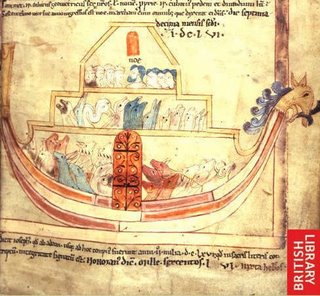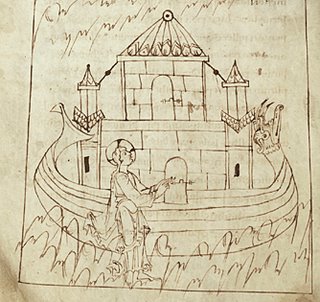 I'm working on an Old English paper that examines the Flood Narrative (Noah's Ark ...) in an Old English poem. One of the things that I've been looking at is how the Ark was portrayed by Anglo-Saxon artists. The interesting thing about the Ark's portrayal is how it "uses" the cultural reality of Anglo-Saxon seafaring to imagine the Ark. Take this image, for example, which comes from an illustrated Old English Old testament. What immediately struck me was the way the Ark is shown as having a "beast" / creaturehead prow. It kinda reminds one of Viking ships, I think. The Anglo-Saxons were aware of the more "traditional" ways of portraying the Ark but they chose to do something different with it.
I'm working on an Old English paper that examines the Flood Narrative (Noah's Ark ...) in an Old English poem. One of the things that I've been looking at is how the Ark was portrayed by Anglo-Saxon artists. The interesting thing about the Ark's portrayal is how it "uses" the cultural reality of Anglo-Saxon seafaring to imagine the Ark. Take this image, for example, which comes from an illustrated Old English Old testament. What immediately struck me was the way the Ark is shown as having a "beast" / creaturehead prow. It kinda reminds one of Viking ships, I think. The Anglo-Saxons were aware of the more "traditional" ways of portraying the Ark but they chose to do something different with it.
As sort of the main contrasting image of the Ark from Anglo-Saxon England, here is another image. This time it's from the "Junius" manuscript, which is one of the four extant manuscripts of Old English poetry. I've been playing with a superb CD "edition" of this manuscript and it's just wonderful, the kinds of things that can be done when you're "up close" to textual material like this. I think that the encounter with "old manuscripts" is a very powerful experience and if I were to teach a Lit class (at any level), I would definitely try to incorporate some looking at manuscripts.
Although the "beast/dragon" head of this portrayal seems to make it very similar to the first image, some art historians have pointed out that the nature of the lines (sharper and angular in this one) means that this image is less likely to have been influenced by Scandinavian art (ie the Vikings). But I see more similarity than difference and in either case, the Anglo-Saxons were ship builders too. What I'm more interested in is the way the second image portrays the Ark with buildings, without showing you what's inside. One art historian's argued that this second image of the Ark makes the it look like an Anglo-Saxon Church, and that this is in conversation with the common medieval typological association of the Ark as the Church. I think that the image also makes one think about city walls, and that the image may be invoking the Anglo-Saxon "burhs", which were pretty extensive towns and played a role in defending the population from Viking raids.
A final image of the Ark. This time, it's from the Junius manuscript again. However, it figures the Ark very differently as Noah and his family are about the disembark. Instead of a ship-like image, we have something more "abstract":

This portrayal of the Ark has been described as "lemon" shaped (my amusement with the vocabulary of art criticism has never ceased ....) A clever critic posits that it's the artist's experiments with perspective, where there's a simultaneous depiction of the Ark from a overhead aerial view and a side view of the disembarkation. Someone else has pointed out that the "aerial view of the Ark" theory makes sense also because Anglo-Saxon burial mounds have shown graves laid out in the shape of a ship. And this of course, ties in nicely with the idea of the Ark=sarcophagus=dying to be born again. Anyway, it's all pretty intriguing to me!
No comments:
Post a Comment